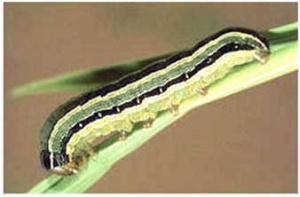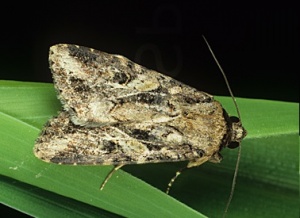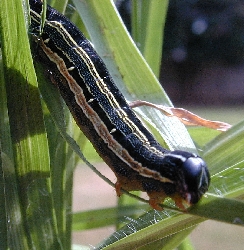Difference between revisions of "Armyworm"
(→Diet) |
(→Not one specie) |
||
| Line 30: | Line 30: | ||
S. exempta may also be succesfully reared on thin lamellae. (5 g. / individual, 60% survival)[http://www.cabdirect.org/abstracts/19926782362.html;jsessionid=182A650567F0EAB465A752FB05768CEF] or dried maize-leaf powder renewed at weekly intervals. (> 90% survival. At 25°C eggs hatched in 3 days, larval period was 12–16 days and pupal period 10-12 days.) [http://onlinelibrary.wiley.com/doi/10.1111/j.1570-7458.1975.tb02374.x/abstract] Rearing armyworm on a simple diet with milled good quality grass as the main diet constituent will not negatively affect fecundity of adults.[http://www.researchkenya.or.ke/node/28860] | S. exempta may also be succesfully reared on thin lamellae. (5 g. / individual, 60% survival)[http://www.cabdirect.org/abstracts/19926782362.html;jsessionid=182A650567F0EAB465A752FB05768CEF] or dried maize-leaf powder renewed at weekly intervals. (> 90% survival. At 25°C eggs hatched in 3 days, larval period was 12–16 days and pupal period 10-12 days.) [http://onlinelibrary.wiley.com/doi/10.1111/j.1570-7458.1975.tb02374.x/abstract] Rearing armyworm on a simple diet with milled good quality grass as the main diet constituent will not negatively affect fecundity of adults.[http://www.researchkenya.or.ke/node/28860] | ||
| − | |||
| − | |||
| − | |||
Revision as of 17:56, 27 August 2014
African Armyworm - Spodoptera exempta


The African Armyworm (4 cm long) is also called Okalombo, Kommandowurm or nutgrass armyworm. It is the larval stage of a moth. It does well on wet conditions and do not proliferate in dry conditions. It has been observed in East Africa and African countries south of the Sahara, Saudi Arabia, Yemen, pacific islands, south-east Asia and Australia.[5] The moths (av. 1.6 cm long, wingspan 3 cm) live about 10 days. One female maximally lays 1000 eggs in total. The eggs are laid in clusters on leaves, and hatch in 2–5 days. The egg mass is covered with black hairs from the female. Larval stage lasts 14 to 22 days; pupal phase takes 7 to 15 days; and adults lifespan is 5 to 16 days. Female moths lay eggs at night in batches of 10 to 300 eggs in one or more layers on the leaves or on other surfaces. In East Africa the total lifecycle lasts about 25 days at an average temperature of 26°C.[6]
Population density
At high density (whichmay be up to 1000 per square meter) the caterpillars are black with yellow stripes. At low density, they are green or brown. They turn black when they are 10 days old. The larvae are not just darker, but also more resistant to baculovirus infection when reared at high density (gregarious form) compared to being reared singly (solitary form). This is due to elevated vertical transmission of infection in gregarious caterpillars. [7] The gregarious larvae have higher nitrogen conversion efficiency on an extreme protein-limiting diet, and accumulate more lipid per amount of carbohydrate consumed on carbohydrate-deficient diets.[8]
Temperature
Temperature dominantly affects larval and pupal development time, larval and pupal survivorship and pupal weight. The higher the temperature (34°C, 28°C or 22°C), the faster they grow. Survivorship in larval and pupal stage is generally lower at 22°C. Larvae reared at high temperature exhibit lighter coloration.[9]
Diet
The Spodoptera exempta larvae feed on all types of wild grasses (Poaceae) and sedges (Cyperaceae), and on early stages of grains. They grow faster (and bigger) on well watered plants (80-90% moisture content) vs water stressed plants (60-70% MC). Survivorship is generally lower on water stressed plants in very young and older larvae.[10] The larvae posses receptors with sensitivity for specific sugars.[11] They prefer more carbohydrate over more protein.[12] But the opposite is true when virally or parasitically infected.[13]
High silica in grasses and sedges inhibits Armyworm growth. Seven of the ten most important food crops are silicon accumulators. The silica content of grasses (eg Bromus species and Eustachys paspaloides) can be considerably higher than in many other plants. Silica levels are lowest in the stem fraction. The level of silica in grasses may co-depend on the level of silica in the soil, availability of water [14], the pH of the soil and temperature. However, there is no consistent relationship berrveen silica content and annual precipitation.[15] Water use per biomasse is lowest in regions with a high rainfall to evaporation ratio. Grasses that utilize water more efficiently, have lower silica contents. As a result, Prairie cordgrass (Spartina pectinata), Switchgrass (Panicum virgatum), Big bluestem (Andropogon gerardii) and Prairie sandreed (Calamovilfa longifolia) contain relatively little silica. [16] Grasses may also solubilize silicate from clay. [17] In perennial grasses, the main source of silica is from monosilicic acid (soluble silica) in the water. Silica levels in grasses are highly influenced by the monosilicic acid contents of the soil. As a result, clay soils result in higher silica contents in grasses than sand.[18] Silicification in non-grass species is probably less dependent on soil silica availability [19] and water availability.[20]
The addition of silicon to the soil increases the size, shape, number and density of spines and phytoliths in the leaves of grasses.[21] And when defoliated by herbivores, silicate contents may increase 4-fold in response [22], but not nearly so much in grasses clipped with scissors.[23][24] Silica is deposited as phytoliths in leaves. These are harder than tooth enamel.[25] Phytoliths may also disrupt microbial action in the gut.[26] Spodoptera exempta cannot easily adapt to physical defences such as silica. Silica in the leaves of grasses (2-5% of dry leaf mass [27]) acts as a defence. Even with short-term exposure, but also progressively impacting with time, silica reduces the conversion efficiency of food into bodymass, and the amount of nitrogen absorbed from their food, leading to reduced growth rates. Exposure to silica-rich diets also caused an extremely rapid increased mandible wear.[28] This results in mechanical protection of resources in chlorenchyma cells. As a result of this (and of the disrupting influence of phytoliths on microbial action in the gut), less chlorophyll is released after grinding and more chlorophyll is retained after passing through the gut.[29] Panicum coloratum (a medium-high grass) contains only 1.21% silica.[30]
S. exempta may also be succesfully reared on thin lamellae. (5 g. / individual, 60% survival)[31] or dried maize-leaf powder renewed at weekly intervals. (> 90% survival. At 25°C eggs hatched in 3 days, larval period was 12–16 days and pupal period 10-12 days.) [32] Rearing armyworm on a simple diet with milled good quality grass as the main diet constituent will not negatively affect fecundity of adults.[33]


